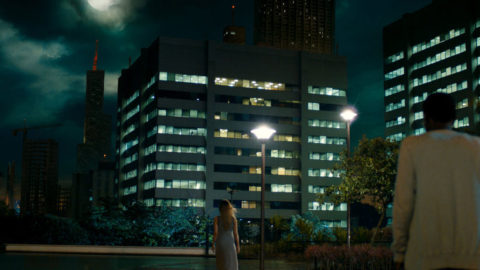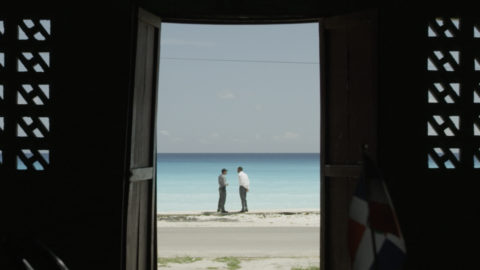Festivals: Locarno 2017
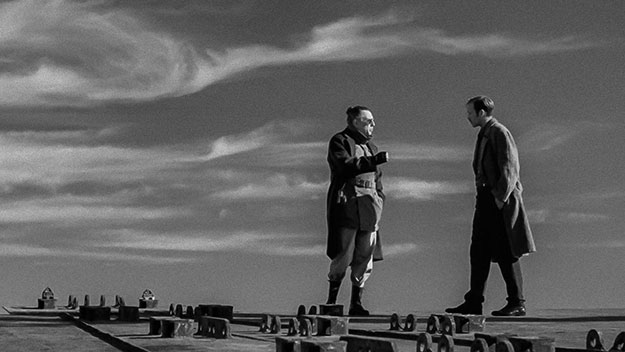
9 Fingers
With little hierarchy as to age, style, subject, or prestige, the selection of new and old films at the 70th Locarno Festival was one of its most pleasingly eclectic yet. In fact, the two retrospective programs—a complete survey of Hollywood genre journeyman Jacques Tourneur and a generous sampling of the defiantly difficult works of Jean-Marie Straub (on hand to receive the Pardo d’onore Manor for lifetime achievement)—work as convenient signposts to the festival’s curatorial philosophy and open-minded conception of cinema in all its forms, past and present.
Genre played a welcome role in the Competition, represented by a black-and-white neonoir (F.J. Ossang’s 9 Fingers, winner of the Best Director prize), an allegorical werewolf film from Brazil (Good Manners, from the team of Marco Dutra and Juliana Rojas, winner of a Special Jury Prize), and a comic reimagining of a popular gothic parable (Serge Bozon’s Madame Hyde, which won the Best Actress award for its star, Isabelle Huppert). Straub’s influence was perhaps more difficult to gauge, but his rigorous approach to form and history could be felt in many of the more adventurous sidebar selections, whether in the arch reenactments and tableau stagings of Narimane Mari’s Le fort des fous, the plan Straubien camera moves that punctuate Nelson Carlo De Los Santos Arias’ Cocote, or the poetic readings and textual reframings of Astrid Johanna Ofner’s Farewell.
The work of Chinese documentarian Wang Bing continues to resemble nothing so much as itself in Mrs. Fang, winner of the Competition’s top prize, the Golden Leopard, awarded by a jury led by Olivier Assayas. A deceptively simple film, Wang’s latest finds the director working in a familiar mode of unadorned observation, applying his acute sense of duration to that most terminal of scenarios: death. Wang’s subject, 68-year-old Fang Xiuying, seen in a brief prologue looking relatively healthy, is in reality undergoing a prolonged battle with Alzheimer’s disease; in just over one year she’ll be dead. Set during the last 10 days of Fang’s life as she lay in bed motionless, eyes frozen and mouth slightly agape, the outline of her skull pressing firmly against her withered skin, the film is an unflinching confrontation with mortality and the transient nature of the human body, as well as a provocative meditation on documentary ethics. Though a majority of the film transpires at Mrs. Fang’s bedside, with assorted friends and family members paying their respects and matter-of-factly discussing her condition and the practicalities of her imminent passing, Wang does provide the occasional wider glimpse of the sociological particulars of life in the family’s eastern Zhejiang village. The men work mostly as fisherman, and Wang captures their lengthy nighttime sorties, as well as the surrounding post-industrial landscape, with the same patient interest as he does Fang’s deterioration. Befitting its intimate subject matter, Mrs. Fang is a smaller film than some of Wang’s more panoramic studies of contemporary China, but there’s a potency to its scale and an undeniable power to its directness. A major festival win for one of the world’s great documentary filmmakers was long overdue.
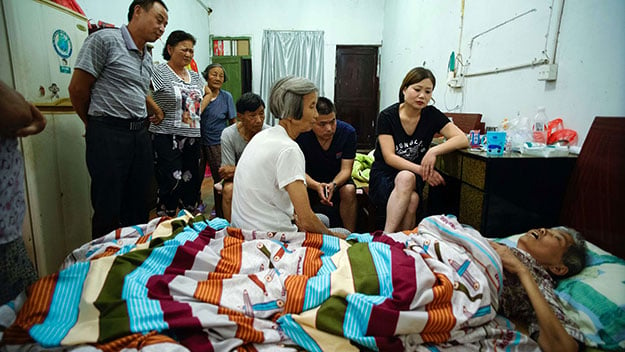
Mrs. Fang
One of the Competition’s other highlights wasn’t a new work at all, but a previously unreleased film by a giant of European cinema that was originally begun over 25 years ago. La telenovela errante, a film Raul Ruiz shot in 1990 but left still unfinished upon his death in 2011, competed posthumously at the festival that first brought his talents to an international stage: his first feature, Three Sad Tigers, won Locarno’s top prize in 1969. No stranger to genre, Ruiz envisioned La telenovela errante not simply as a satirical send-up of the soap opera, but a wholesale adoption of the format’s narrative and stylistic idiosyncrasies. (No surprise Ruiz had worked briefly as a screenwriter of telenovelas in the mid-1960s.) Edited and completed by his widow Valerie Sarmiento, the finished film is episodic by design, its form and content a byproduct of the era’s many lingering sociopolitical concerns. (Pinochet’s 17-year dictatorship had ended just months prior.)
Each of the film’s segments, demarcated by day, introduce discrete comic and melodramatic scenarios only to reveal themselves as part of an increasingly interconnected series of soap operas broadcasting everyday Chilean reality. In the first, a volley of mannered sexual and political entendres between a philandering couple erupts into a frenzied confrontation with the woman’s jilted husband (who, of course, also happens to be the man’s brother); in another, a parade of guerrilla fighters are shot down one by one as two men, seated in a parked car, struggle to find common linguistic ground despite ostensibly speaking the same language. Clearly relishing the stylistic leeway afforded by the genre—the film’s prismatic color palette and exaggerated decoupage provide enough aesthetic pleasures to make one mourn yet again the absence of one of cinema’s great stylists—Ruiz takes as fanciful an approach to the film’s visual design as he does its object of critique. Ruiz, an artist of countless stories and endless discoveries, lived life to the fullest, never betraying his devious sense of humor, even from beyond the grave: “If you behave badly in this life, you’ll become a Chilean in the next,” reads the final episode’s introductory title card.
Dedicated to first and second features, the Filmmakers of the Present program has in recent years produced many of Locarno’s standout titles. Six years ago Valérie Massadian’s Nana won the festival’s prize for best first feature; this year the French filmmaker belatedly returned with her follow-up, Milla, a quietly moving and unassumingly profound film about growing up, young motherhood, and life’s chance occurrences. As the film opens, the 17-year-old title character is cuddled up with her boyfriend in an abandoned car, windows fogged over from a cold night’s sleep. Scavenging items from discarded piles of junk, Milla (Séverine Jonckeere) and Leo (Luc Chessel) set themselves up in an empty house in the north of France, where they live hand to mouth, seemingly content in life and in love. Massadian films their activities with a non-judgmental, compassionate eye; Milla and Leo aren’t criminals or junkies, but rather two recognizable teens forced to fend for themselves in the cruel light of day. When Milla gets pregnant and Leo takes a job on an industrial freighter, their individual priorities must change, and the film, eliding the details of their separation, refocuses on Milla and her newborn baby. Instead of distancing the viewer from the drama, the film’s bifurcated structure and Massadian’s casually radical approach to time—the narrative is more than once breached by unexpected conflations of music and memory—yield a strikingly tangible sense of accumulated experience, forming a beautifully symmetrical whole.
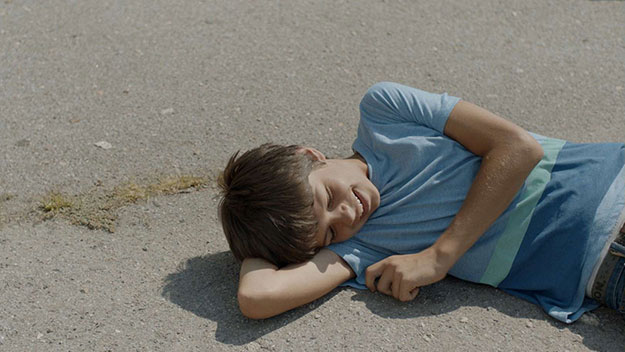
3/4 (Three Quarters)
An equally poignant family portrait, Illian Metev’s Filmmakers of the Present winner 3/4 (Three Quarters) also hinges on the absence of a partner and the rewards of perseverance. Raising two children in suburban Bulgaria, single father Todor (Todor Velchev) is facing the departure of his eldest, Mila (Mila Mikhova), a piano student preparing for a big audition in Germany, while his younger son, Niki (Niki Mashalov), idles away the summer through benign fits of juvenile humor and adolescent angst. Backstory is sparse: beyond an early reference to the children’s absent mother, she’s never seen or discussed; Todor, an astrophysicist, cares deeply for his children but seems to more comfortably interact with a junior colleague. Metev, who up to now has worked in nonfiction, has an extraordinary sensitivity for family dynamics; Niki and Mila converse with and annoy one another with an impressively natural rapport, while their frustrations with Todor’s laissez-faire attitude manifest in subtle displays of resentment. Working with cinematographer Julian Atanassov and acting as his own editor, Metev confidently arranges this modest narrative around inventive compositions and the suggestive use of offscreen space. The film’s signature image is a backwards tracking shot that moves in step with the characters as they walk in the direction of the camera, with whatever might lie before them left tantalizing out of our view. “Save your strength. There’s a long ascent ahead,” Todor instructs as the trio set off on a hike in the film’s delicate final passage, perfectly encapsulating the love that will keep this family close, no matter the destination.
Locarno’s other main program, Signs of Life—a newly competitive section this year on which I served as part of the three-member jury—seeks, per festival literature, “to explore the frontier territories of cinema.” This year’s selection, which included work by established filmmakers (Radu Jude, Giovanni Columbu) and first-timers (Rana Eid) alike, traversed these territories in both literal and artistic terms. A film shot high above the Gaza Strip (Basma Alsharif’s Ouroboros), for example, sat comfortably alongside a short set among the ruins of contemporary Ukraine (Dane Komljen’s Fantasy Sentences), just as an essay film (Jude’s The Dead Nation) shared space with a near-wordless formalist fantasia (Clément Safra’s Filmus). The top prize went to Cocote, the second feature by Dominican filmmaker Nelson Carlo De Los Santos Arias. A musically and culturally rich tale of revenge set in small village in the Dominican Republic, Cocote follows Alberto (Vicente Santos), a gardener and Evangelical Christian working for a wealthy family in Santo Domingo, as he returns home after hearing his father’s been brutally murdered by local police.
What might read as familiar on the page is rendered strangely askew by De Los Santos Arias, who takes an anthropological approach to the scenario, documenting age-old religious and burial rituals through an immersive integration into a remote, self-sufficient community, a process reflecting the director’s roots in nonfiction. Likewise, his bold but never overly indulgent stylistic touches—mixing color and black-and-white film stocks, blending fictional scenarios with verité-like footage, and implementing a formally calibrated compositional strategy that never betrays the medium’s observational nature—lend Alberto’s inner conflict an apt aesthetic complement.
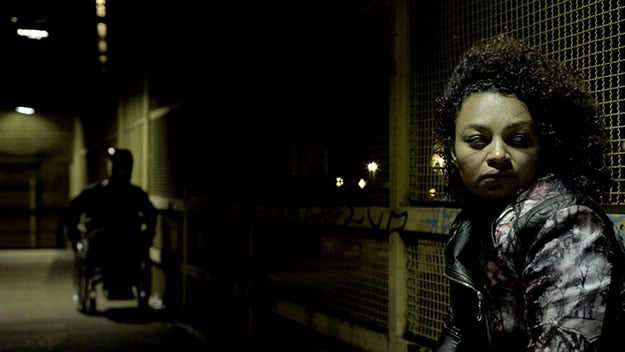
Once There Was Brazilia
Awarded a Special Mention in the same section for its unique and uncompromising vision, Adirley Queirós’s Once There Was Brazilia parlays the futuristic trappings of allegorical science fiction into a bracing present-day polemic that weaponizes the cinematic apparatus in a manner more common to documentary than fiction. This dialectic is at the heart of Queirós’s practice; his previous feature, White Out, Black In, a fascinating hybrid object, couched first-person testimonials in a temporally elastic narrative that merged multiple eras of state-sanctioned violence with Afrofuturist aesthetic flourishes. Once There Was Brazilia goes back to the future through different means: following an arrest on his home planet, the intergalactic agent WA4 (Wellington Abreu) is ordered to travel to Earth and assassinate the president of Brazil. His 60-year journey across the galaxy accounts for much of the film’s first act: incessantly smoking and grilling meat on a makeshift grill inside the cabin of his small spacecraft, WA4 hurtles toward Earth on a mission to overthrow a fascist regime and save his own life in the process. When he crash-lands in Ceilândia, he joins the resistance and emboldens a small legion of insurrectionists. Operating well beyond the modest means of production, Queirós has delivered a spectacular vision of the near-future, with an army of non-actors set forth under a night sky ablaze with violence and the sounds of war echoing on the horizon. (In one unforgettable shot, a man in a wheelchair sits looking on at the skyline under siege as PA announcements from Brazil’s president Michel Temer play ominously.) Shot in rich nocturnal hues by compatriot and fellow filmmaker Joana Pimenta, Once There Was Brazilia offers a bracing and troubling image of Brazil’s current political climate.
Screening out of competition, Blake Williams’s unclassifiable PROTOTYPE offered its own retrofuturist marvels in the intoxicating language of pure sound-image abstraction. The Texas-born, Toronto-based experimental filmmaker’s first feature-length work—and first shot in stereoscopic 3D following an inspired run of anaglyph shorts—PROTOTYPE begins as a meditation on the devastating 1900 Galveston hurricane and its aftermath before blossoming into a sensorial dispositif concerning technology, image-making, and the landscape of memory. Archival images of Galveston locals, seen in a silent overture that calls to mind the photographic prologue of Pedro Costa’s Horse Money, reverberate throughout the film through new and repurposed footage of the American Midwest, swells of oceanic audio, and early cinematic iconography evoking everything from silent serials to Eadweard Muybridge. Moving between eras and environments by way of rephotographed 3D footage captured from vintage television monitors (shades of Godard’s Numéro deux), Williams suspends and distends time through an array of inventive techniques both archaic and cutting-edge.
A prescient work in more ways than one (as of this writing Hurricane Harvey has dumped a catastrophic 48 inches of rain across south Texas), PROTOTYPE seems to exist in multiple temporal spheres at once. Midway through, a stunning interlude in which the disembodied vocals of Marilyn Monroe float atop the sound and fury of a slowly undulating, digitally modulated seascape uncannily echoes a similar sequence in the epochal eighth episode of Twin Peaks: The Return. By returning to the past through the technology of the present, PROTOTYPE unassumingly crosses the line from forward-thinking to downright clairvoyant.
Jordan Cronk is a critic and programmer based in Los Angeles. He runs the experimental screening series Acropolis Cinema and is co-artistic director of the Locarno in Los Angeles Film Festival.



